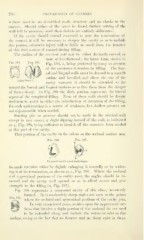Page 238 - My FlipBook
P. 238
236 rUEPARATION OF CAVITIES.
it there must be no dccaloitied tooth structure and no checks in the
enamel. Shoukl either of the latter he found, further cutting of the
wall will be necessary until these defects are entirely obliterated.
If the cavity should extend rootward to near the termination of
the enamel, it wall be necessary to deepen the cavity so as to include
this portion, otherwise injury will be liable to result from the fracture
of this frail section of enamel during filling.
The outline of the cervical wall may be either distinctly curved or
more or less flattened ; the latter form, shown in
Fig. 194.
Fig. 194, A, being preferred by many on account
of the assistance it renders in filling. The buc-
cal and lingual walls must be dressed to a smooth
outline and bevelled, and where the size of the
B C
(After Black.)
cavity warrants it should be extended so far
toward the buccal and lingual surfaces as to free them from the danger
of future decay. In Fig. 195 the dark portion represents the buccal
aspect of the completed filling. None of these walls should be deeply
undercut to assist in either the introduction or retention of the filling,
for such undercutting is a source of weakness, but shallow grooves are
not objectionable when needed.
Starting pits or grooves should not be made in the cervical wall
exce])t in rare cases ; a slight dipping inward of the wall, as indicated
at A, Fig. 196, being sufficient to furnish all the retentive form needed
at this part of the cavity.
That portion of the cavity in the sulcus on the occlusal surface may
Fig. 196. Fig. 197.
Prepared cavities and anchorages.
be made retentive either by slightly enlarging it inwardly or by widen-
ing it at its termination, as shown at A, Fig. 196. Where the occlusal
and approximal portions of the cavity meet, the angles should be re-
moved and the cavity well opened so as to afford access and give
strength to the filling (b, Fig. 197).
Fig. 198 represents a compound cavity of this class, incorrectly
formed. In it moderately sharp angles are seen at the points
Fig. 198.
where the occlusal and approximal portions of the cavity join.
In very exceptional cases, cavities upon the approximal sur-
faces that involve a slight portion of the occlusal do not need
to be extended along and include the sulcus or sulci on this
surface, owing to the fact that no fissures and no decay exist in them.


